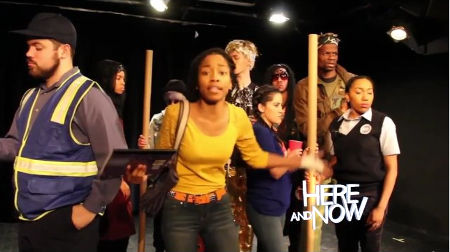SUBWAY
STORY
(A SHOOTING)
| Sarah Q. Shah (foreground) and cast of "Subway Story (A Shooting)" by William Electric Black. The beige cardboard poles are used choreograhically to simulate the poles of a subway car. Photos by Jonathan Slaff. |
 |
February 22 to March 18, 2018
Theater for the New City, 155 First Ave. (at E. 10th Street)
Presented by Theater for the New City
Thursdays through Saturdays at 8:00 PM, Sundays at 3:00 PM
$15 general admission, $12 Seniors/Students, $10 groups
Box office (212) 254-1109, www.theaterforthenewcity.net
Group sales: Alex Santullo (212) 475-0108
Running time 85 min.
Innumerable American children and teens are exposed to gun violence at home, in school, in their communities and in the media. In "Subway Story (A Shooting)," playwright/director William Electric Black means to elucidate the pressures that drive the epidemic in young people. The piece is the final installment of his five-play GUNPLAYS Series, which has dramatized the epidemic of gun violence using differing approaches and theatrical styles. Theater for the New City, which has presented the entire series, will mount "Subway Story (A Shooting)," its final installment, February 22 to March 18 in its Community Theater.
A series of talkbacks with experts in various fields on three Sundays following the show aim to elucidate the pressures driving gun violence in young people.
READ
OUR REVIEW IN
STAGE
BUDDY
SEE US ON TV:
 |
Click
picture to watch segment on WABC-TV's "Here and Now"
Aired: Feb. 11, 2018 |
 |
| Click picture to watch segment on New York 1 "In Focus" with Cheryl Wills. Aired: March 4, 2018. |
BACKGROUND
Early this year, The Federal Centers for Disease Control and Prevention,
based on 2014 data, reported that homicide is the leading cause of
death for Black males between 15 and 34. Among the twenty-one NYC
teenagers who died violently in the past twelve months, all were Black
or Hispanic; all but one were male and all but two were shot. Irrespective
of other circumstances, these victims shared a common reality: they
grew up in poverty-stricken communities where threats of violence
and death are constant. Studies show that youths who witness gun violence
experience similar negative psychological and physical harm as youths
who have had direct exposure. Of all the risk factors, the strongest
and most consistent predictor of youth gun violence is exposure to
or history of violence. In addition, the access to and availability
of firearms increase the likelihood of weapon-related violence among
youth.
Reviews
of literature on gun violence reveal that violent crimes in urban
areas are more likely to involve guns than in suburban or rural areas.
While school shooters tend to be from stable, low crime towns and
suburbs who generally do not know the people they kill, street shooters
tend to live in densely populated areas with high levels of crime
and poverty, and they tend to kill individuals they know.
| A teacher (Levern Williams) makes it clear to a high school student (Sarah Q. Shah) that she must complete a composition to be promoted to the next grade. | A transgender boy named Emmett offers a gun to an abused teenager named Chevonn, in exchange for her killing him since he is being bullied in school. L to R: Natalie Martino and Sarah Q. Shah. |
ABOUT
THE PLAY
"Subway Story ( A Shooting)" is the unfolding of an essay
by an African-American teenage girl named Chevonn, which she must
complete to pass junior English. It is supposed to be nonfiction but
instead turns out surprisingly literary in style. In her composition,
a troubled, abused high school student combs the subways, seeking
to obtain a gun in order to shoot her mother. Her quest is narrated
in a fantastical mashup of literary images that are part Lewis Carroll
and part queasy reality, revealing issues affecting our children including
alienation, discrimination, bullying and the easy availability of
firearms. Chevonn's autobiographical tale strongly suggests how society
needs to perceive the hopelessness that kids face and how this can
make them lash out with guns or turn them on themselves.
Chevonn
has been physically abused by her mother and sexually abused by her
father. The girl of her story, like many teens of lower income, dysfunctional
households, seeks a gun to end the pain. Along the way, Chevonn meets
subway-dwellers whose stories she captures in her composition book
and she wrestles with her own destiny while encountering a succession
of hidden sufferers. As their stories unfold, so do stories about assault,
gender bias, homelessness, the plight of Dreamers, hatred toward
Muslims and the effect of gun violence on people of color. Chief among
the young woman's encounters is a transgender boy named Emmett who
has a gun because he was bullied in school and seeks escape through
suicide. He would like Chevonn to kill him and then use the gun against
her mother. Others include a homeless veteran named Army who packs
an assault weapon, suffers from PTSD and is pursued by the authorities.
Dodging the police who are chasing Army, Chevonn retreats to the supposed
"safety" of her mother's house, where she overcomes her
inability to cry, using her tears to finally put out the fire in her
soul.
| John Patterson as the character of a glam rocker who calls himself God. He strolls through the subway asking folks to give up their avocado toast, Zero Coke, and Beyonce hitlist and walk on the wild side - for the former things are passed away. | An abused teen girl, Chevonn (R), rescues a transgender boy, Emmett (C) from two high school thugs. L to R: Yessenia Rivas, Sebastian Gutierrez, Natalie Martino, Sarah Q. Shah. | Chevonn's mother, Mrs. Johnson, tells her trhat she must take life's pain without crying--the same lesson her mother gave her. L. to R: Sarah Q. Shah and Jacqueline Chinonso Nwabueze. |
The play
challenges us to realize what leads young people to gun violence:
a convergence of individual, family, peer, school and community risk
factors. We are prompted to ask ourselves: are we desensitized or
numb to the pressures our children endure, like people who stand passively
by while tragedies incubate in plain sight around them?
As Americans, we are now struggling to find our bearings after two months of mass shootings--Las Vegas, the Baptist Church in rural Texas and Rancho Tehama Elementary School near Sacramento. This play does a service by bringing our focus back to the larger problem of gun violence among young people in urban settings. Interestingly, while mass shootings grab the headlines, they account for less than one percent of gun deaths each year. Here's a revealing comparison: The death toll from our three recent mass shootings was 90, but in 2016 there were about 6,600 gun-related deaths among youths 24 and younger.
| A transgender boy (Natalie Martino, center) is restrained by an abused teenage girl (Sarah Q. Shah, right) from jumping into the subway tracks. |
CAST
AND STAFF
The actors are Sebastian Gutierrez, Jeremy Lardieri, Mohamed
Madboly, Natalie Marie Martino, Brandon Mellette, Jacqueline
Nwabueze, John Patterson, Yessenia Rivas, Tournesoul, Camille
Upshaw and Levern Williams. Cast understudy is Ann-Kathryne Mills.
Written and directed by William Electrric Black. Set design is by Lytza Colon and Mark Marcante. Costume and prop design are by Susan Hemley. Lighting design is by Alexander Bartenieff. Sound design is by James Mussen. Sound tech is Alex Santullo. Stage Manager is Megan Horan. Production Manager is Dylan Vaughan Skorish. Percussion advisor is Jacob Shandling.









